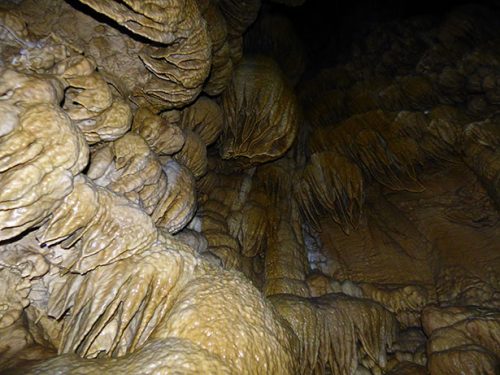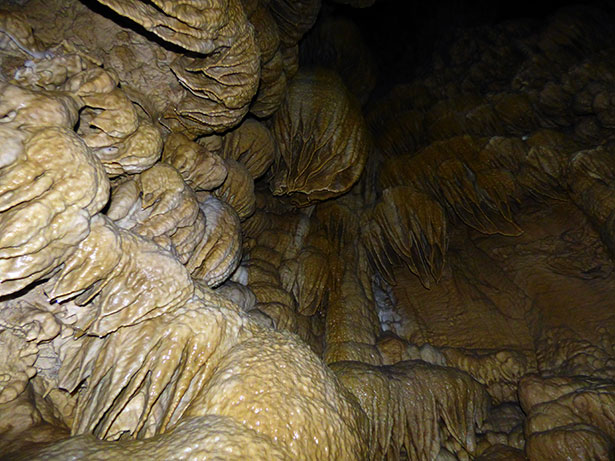
 |
| Jellyfish-like ‘Drapery’ form the walls of oregon caves |
I’m the kind of person who squeaks gleefully at the sight of tiny, rodent-like creatures in their natural habitat. In this, Oregon Caves National Monument and Preserve meets every expectation. Also, the caves are amazing.
Found within the Siskiyou Mountains in the southwestern portion of the state, the Oregon Caves lure in about 80,000 visitors a year to tour the glistening marble caverns and relish in the drippy delight that being underground can bring.
I visited the caves in 2000 as a 10-year-old, but went back for another tour last year to see if the spooky appeal lasts into adulthood. Short answer: It does.
The national monument, established in 1909, was expanded in 2014 to occupy nearly 4,600 acres of protected land. The acreage sprawls with meadows, forests and rocky crags, some accessible through the monument’s trail system.
The caves, of course, are the main feature. Visitors aren’t allowed to tour alone, but a number of guided tour options exist — it’s more fun to travel in a group, anyway. The general cave tour features a 90-minute exploration through the underground system, which follows the flow of the appropriately named River Styx through the first half of the journey.
One stunning feature is the “Banana Grove,” where mineral formations called “drapery” create odd, jellyfish-like shapes on the cavern wall. Later, a huge column where a stalactite grew to join a stalagmite bears testament to the eons of geologic time.
For cynics, there are plenty of lose-your-faith-in-humanity moments waiting around every corner — explorers from centuries past have ripped off stalactites or — wait for it — signed their names into the marble wall, creating permanent graffiti for future generations to scorn.
More adventurous spelunkers have a few options to enrich the cave exploration experience. First is the off-trail caving tour, which has sadly wrapped up for the season but will open up again next summer. It’s three hours in jumpsuits, crawling on rocks and squeezing through challenging crevices. The tour costs $45 per person, but is well worth it for dedicated climbers.
With Halloween just around the corner, the “haunted candlelight” tour is a slightly creepier spin on the regular tour. Tour guides tell ghost stories while candles flicker inside old-timey lanterns.
My partner and I opted for the general tour in mid-summer, and once we stumbled out of the cave shielding our eyes from the too-bright outdoors, the rest of the day loomed before us. That’s when a butterfly flittered by and we went chasing after it with cameras.
Oregon Caves is pleasantly surrounded by nature, providing lots of opportunities to cross paths with critters. While there, I watched a deer munching on underbrush, took delight in the aforementioned rodent-like creatures that skittered about and snapped photos of a lizard basking in the sunlight.
A few hikes surround the caves, including the 3.3-mile Big Tree Trail loop, which — big surprise — features an enormous Douglas fir tree midway through the trail. The path wasn’t well maintained, but if you’re into plowing through tall grasses bushwhacking style, it’s an exciting experience.
Another trail to try out is the strenuous Bigelow Lakes-Mt. Elijah loop, a 9.2-mile journey to the peak of Mt. Elijah, which gives a dazzling panoramic view of the area, including a glimpse of Mt. Shasta when skies are clear.
At the end of the day, we camped at Grayback Campground, a small site near the caves. A more glitzy option is the 23-room Oregon Caves Chateau, a beautiful wood lodge with dining, coffee and comfy rooms to snooze in.
Cave season ends Nov. 1, so go check out the caves soon or plan a trip when they open again on March 21.
Directions: From Eugene, get on I-5 South for about two hours, then take Exit 58 to merge onto OR-99/Redwood Highway. After 3 miles, turn right at US-199 to Cave Junction. Turn left on OR-46. After 20 miles, arrive at Oregon Caves. Watch out for windy roads the last 10 miles.